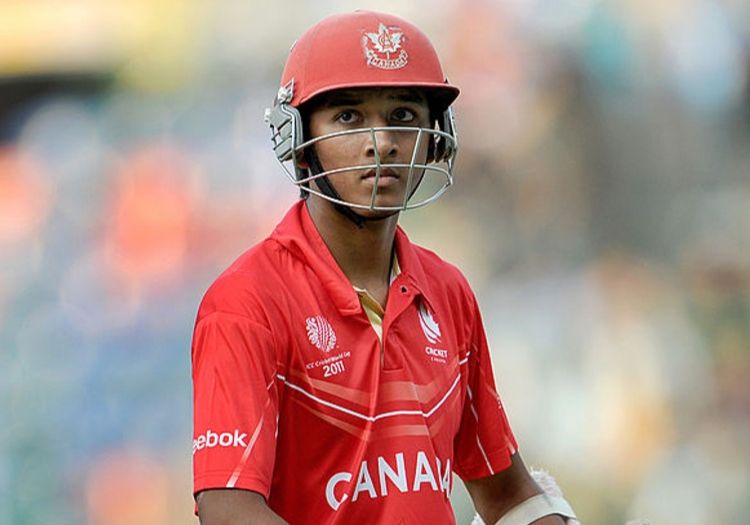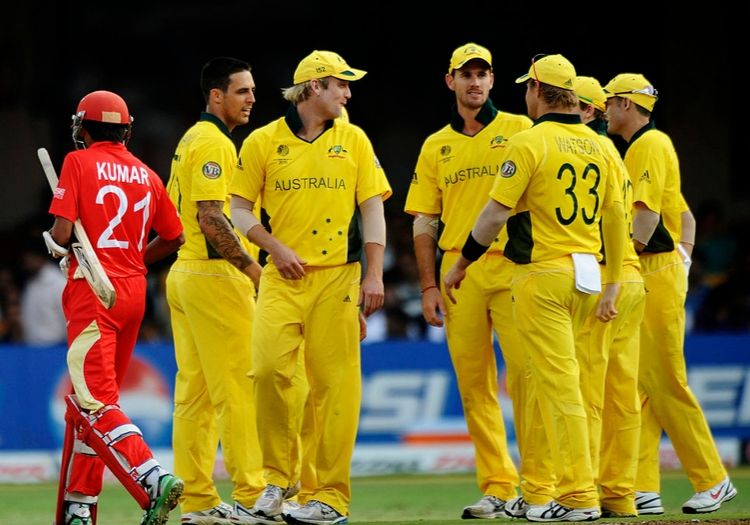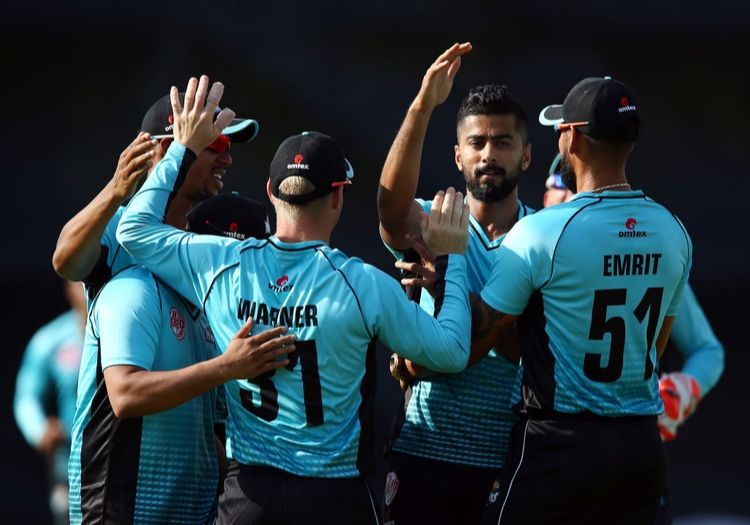NICK FRIEND: Kumar is the youngest player in World Cup history but since 2011, Canada have not taken part in a global tournament. It is why, in a sense, the next fortnight is so important. No Canadian side has ever featured at the T20 World Cup


Nitish Kumar laughs when you remind him of his unlikely claim to fame. His 25-year-old self has been involved in international cricket for a decade; he exists as the fourth-youngest player in the history of ODI cricket. It is one of those fairly baseless statistics; Kumar doesn’t resent it, but he brushes it off.
“I don’t like that one,” he admits with a chuckle. “It’s one of those things that just happened in that moment. I guess there were other guys who could have done it as well.”
Carded to come in at number five, a tight run-chase against Afghanistan saw Kumar fall gradually down the order. As Canada edged home by four wickets, the teenager was a mere spectator.
That was a different time, a time when Canada could regularly compete with the Afghans – a side that featured Mohammad Nabi, Mohammad Shahzad, Asghar Afghan and others – and come out on top.
This was two years after the 2007 World Cup and two years before the following tournament; Canada were at both, led first by John Davison and then by Ashish Bagai.
It was a team to be proud of, an example to follow, a reason for being, an inspiration for an Ontario-born dreamer. At the 2011 tournament, Kumar became the youngest player in to play in a World Cup.
“More than being the youngest player, I was put into a setup where I could improve and I was happy about that,” Kumar remembers of the early days.
“More than my debut at 15, it was about being part of the national team and having that chance to work with that team and those coaches. It was a great setup to be in.”
That was then and this is now. Since 2011, Canada have not taken part in a global tournament. It is why, in a sense, the next fortnight is quite so important. No Canadian side has ever featured at the T20 World Cup.
Without wishing to be cynical, this is as good a chance as any. Zimbabwe’s ICC-enforced absence has seen Nigeria take their place in Canada’s group, opening up the draw somewhat.
They will be no pushovers – they handsomely disposed of Kenya in a warmup fixture – but they are not the reputational might of Zimbabwe.
It is to state the obvious to highlight the significance of a World Cup qualifier, but this matters. It matters deeply. And it matters because associate cricket is tough.
If this round-robin competition represents a pathway of opportunity, then it also spells out the cut-throat nature of life beneath the top table.

Kumar became the youngest player in World Cup history in 2011
“When you play associate cricket, you are playing under so much pressure because your life is on the line,” Kumar says.
“If you don’t qualify there’s no money. If there’s no money, there’s no cricket. With all those tournaments, they are one-offs. You play five games. There were a few instances we’d be the top team through the tournament, but then on the last day through net run rate you don’t even qualify.
“I have never really thought the tournaments are a great setup. As an associate cricketer, you’re basically putting three years of cricket – and three years as a cricketer – on the line.
“It only takes one bad game to not qualify because you play each team once. You either go on a run or if you have a poor game then you don’t have cricket for three years.”
That, in a nutshell, is the essence of it for those like Kumar. Missing out on the top four of this year’s World Cricket League Division Two tournament left them in the Cricket World Cup Challenge League, effectively the third tier on the World Cup qualification pathway.
And with the 50-over competition now a 10-team affair – the aftereffects of the game’s governing body’s curious decision to shrink its global showpiece still ringing in associate ears, a return to the heady heights of Kumar’s early years have never appeared so far away.
“Back when I was debuting with the older guys, they used to strive to make it to those World Cup qualifiers and then get to that World Cup,” he recalls. “It was a huge thing because then you finally get to play against these top teams.
“Obviously now, you have Afghanistan and Ireland with their Test status. You have the Netherlands with their ODI team, so they get to play a lot of cricket [in the Cricket World Cup Super League]. But then you have a lot of teams that are just playing – as it was before – against each other.
“If you qualify, then you get to play those other sides, so it’s still a tough one. The pathway is still heavily focused on the top three or four teams in world cricket and it is based around that. That is what it looks like – it’s even tougher now without the 50-over World Cup because that’s what guys used to strive for.”
Kumar does not look for sympathy; only, he states the facts as they are in front of him. For Canada to qualify for the World Cup in its current shape, it would take a feat of epic proportions – a sporting miracle wildly disproportionate to Canada’s place in the global cricketing landscape.
A 10-team World Cup makes little sense, but then that is not news. No other sport is shrinking its flagship event.
He is convinced that a realistic trail towards a World Cup would raise the standard of the game back home.
Those no longer able to commit their time to an effective intangible would find the time; youngsters being tempted away from the game by more enticing alternatives would be lured back. “It’s a tough one,” he says. “It was the most important thing for a lot of the guys.”

John Davison (right) talks to Kumar at the 2011 World Cup
Ultimately, it takes its toll. Kumar knows he is in a privileged position; he is 25, he lives at home, his main concern is his cricket. Yet, life moves on, priorities change. Canada is not cheap and bills need paying.
“At some point in your career when you’re old enough or whatever it is, there will be stuff that is more important than cricket,” he says knowingly.
“In Toronto, it’s super-expensive. At some point, something has to give – it’s one or the other. It’s a tough one, for sure. People have to take time off work and there’s only so much time you can take off work.
“Then if you don’t qualify and you’ve got a period where you’re searching for jobs and then you know that there’s no cricket, it’s not an easy one.”
It all adds up. It is why these two weeks in United Arab Emirates have such game-changing potential. Make it as one of the six top sides and the first group stage awaits in Australia. Fail, and a tiresome cycle begins once more.
Kumar is hopeful; Canada’s squad is a mixture of players who have played in subcontinental conditions before and others who haven’t; some who have played under that kind of pressure and some who haven’t; some who have experienced floodlit cricket and some who haven’t.
Just midway through his twenties, it seems irrational to label Kumar as a voice of reason, but he has been playing at this level for a decade.
He points to the Global T20 Canada as a driver in his own improvements. Its future has been reported to be in some doubt, given the financial difficulties that marred this year’s edition and which saw the inaugural Euro T20 Slam postponed. “It is important for it to keep going,” he insists.
Just being in the company of the stars helps the game of the local players. Chris Gayle, Shahid Afridi, Faf du Plessis and Andre Russell all took part in this year’s tournament. A decade ago, the very idea would have been laughed out of town.

Kumar hopes that the Global T20 Canada continues
“When you’re playing with some of the big guys, it really is huge,” Kumar adds. “They are marquee players in a lot of the T20 tournaments, so if you do well and they are there to see you perform first-hand and they get to understand you as an individual, it’s huge.
“A lot of T20 cricket around the world, I feel, are the same captains. If they are confident with you as an individual and they know what you can offer, they pick you. It just makes it a little bit easier for them to recognise your name.
“They might then sit down and say: ‘Oh, he’s good. I’ve played with him. Go with him.’ You’re much better off that way than if you’re just a name at a draft. It’s quite hard to get picked up then.”
Once upon a time, Kumar planned to forge a career in England. He spent three years at Loughborough University as part of one of the strongest MCCU sides in recent memory, playing alongside Essex’s Sam Cook, Leicestershire’s Hassan Azad, Middlesex’s Robbie White, Gloucestershire’s James Bracey and Northants batsman Charlie Thurston.
In a pre-season fixture against Northamptonshire in 2017, Kumar struck a run-a-ball 141.
Even if a combination of Home Office trouble and visa issues put pay to that dream, it is an experience he reflects upon fondly.
“It’s about being put in a different environment, meeting different people, living with different expectations,” he reflects. “Especially in cricket-playing countries, there’s a way that individuals go about their game. You learn a lot from stuff – it doesn’t just have to be coaching one-on-one all the time; it’s the external stuff that you learn a lot from.
“It’s something that the clubs in Canada could really push their younger players – the guys who are good enough – to go away for a summer or a winter and develop their game further.
“I’m definitely still learning, but watching cricket now and the way it’s going, you constantly need to keep developing your game and finding new ways to become better. If you’re not, you’ll stagnate and stay there.
“If you’re not willing to learn, I don’t really think there’s a spot for you in this sport because it is changing all the time. It’s constant change all the time, so you do have to adapt to it.”
A decade on from his international bow, Kumar is approaching his prime. He has changed and Canadian cricket has changed. In a fortnight’s time, he could change its course once again.
Posted by Sharan on 24/04/2020 at 08:50
Great article, well written and has a beautiful flow - you just want to keep reading!